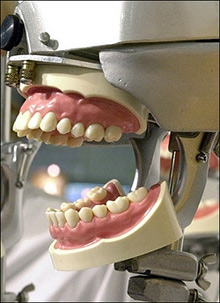 |
 |
 |
 Health & Beauty | June 2006 Health & Beauty | June 2006  
Smile! A New Canadian Tool Can Re-Grow Teeth Say Inventors
 AFP AFP


| | Set of teeth on display at a dental show. Snaggle-toothed hockey players and sugar lovers may soon rejoice as Canadian scientists said they have created the first device able to re-grow teeth and bones. (AFP/DPA) |
Snaggle-toothed hockey players and sugar lovers may soon rejoice as Canadian scientists said they have created the first device able to re-grow teeth and bones.

The researchers at the University of Alberta in Edmonton filed patents earlier this month in the United States for the tool based on low-intensity pulsed ultrasound technology after testing it on a dozen dental patients in Canada.

"Right now, we plan to use it to fix fractured or diseased teeth, as well as asymmetric jawbones, but it may also help hockey players or children who had their tooth knocked out," Jie Chen, an engineering professor and nano-circuit design expert, told AFP.

Chen helped create the tiny ultrasound machine that gently massages gums and stimulates tooth growth from the root once inserted into a person's mouth, mounted on braces or a removable plastic crown.

The wireless device, smaller than a pea, must be activated for 20 minutes each day for four months to stimulate growth, he said.

It can also stimulate jawbone growth to fix a person's crooked smile and may eventually allow people to grow taller by stimulating bone growth, Chen said.

Tarek El-Bialy, a new member of the university's dentistry faculty, first tested the low-intensity pulsed ultrasound treatment to repair dental tissue in rabbits in the late 1990s.

His research was published in the American Journal of Orthodontics and Dentofacial Orthopedics and later presented at the World Federation of Orthodontics in Paris in September 2005.

With the help of Chen and Ying Tsui, another engineering professor, the initial massive handheld device was shrunk to fit inside a person's mouth.

It is still at the prototype stage, but the trio expects to commercialize it within two years, Chen said.

The bigger version has already received approvals from American and Canadian regulatory bodies, he noted. | 
 | |
 |



